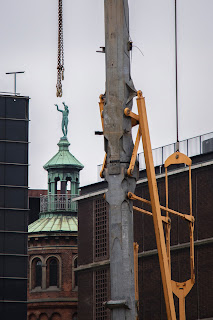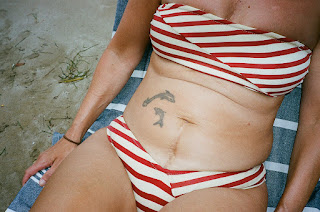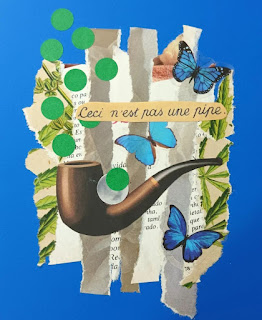💥Pop Sonality Conversation with Asger Korsgaard.
Pop Sonality has had the opportunity to interview one of the most fascinating photographers out there: Asger Korsgaard. This Danish photographer has accomplished a great body of work characterized by real naturalness showing his curiosity and optimistic way to look at life. We have discussed his emotions towards his hometown: Them, his process of work and his opinion about the use of technique, the joyfulness of his series Cemetery, the age factor of his portraits, the vintage look of his analog works, his pop works on the coast and his delightful series Smile. Keep on reading to know all about Asger.
Looking at your captivating thematic galleries on your website or simply having just a glance at your Instagram account, there is no doubt that at your short age of 32 years old, you have managed to get an impressive body of work that could easily be compared with the big photographers in street photography. Congrats on that. My first question is, what is still in you from that 24-year-old danish boy who left Them, your hometown, to explore the world?
A lot I guess, but one of the most relevant things when we are referring to and talking photography, I think is that I really enjoy exploring life outside my own home. Whether it is on the other side of the world, as when I started to take pictures, or just around the corner from where I live is not that important to me. That is to say, I enjoy taking photos no matter where I am, it doesn’t matter if I take pictures around the corner where I live or on the other side of the world. I just enjoy going out looking for things, people, animals, or whatever – and if I see something I find it interesting, funny, sad, beautiful, strange, etc. I photograph it.
What would you say can be seen in your images from your origins and background? Any influences from your place? Do you go back to Them, and have you ever photographed it?
I come from a small village in the countryside. I grew up in a caring family with values like you treat nature, animals, and other people with respect, and you treat others as you want to be treated yourself. I hope you can somehow see these values in some of my photography. My parents and my grandmother still live in Them, so yes, I am often back home to where I grew up. The last time I was home, I spent 2,5 hours taking pictures in my parents’ garden, but I haven’t made any huge photographic projects in my hometown.
Your photography is all about emotions, you have even described your work in terms of the sensations you would like to transmit with them to viewers. You have mastered the street scenes, placing the protagonists like the song of Radiohead says “Everything in its right place”; from people, animals, sculptures, buildings, fences, flowers, and trees, to any other element you encounter, such as smoke, graffitis, and reflections on broken glasses or even on a passing-by glass pane! And what strikes me the most about your images is the perfect timing. The technique is absolutely impeccable too. Do you consider yourself a patient photographer?
Yes, I guess. If I have an idea in my head and I think there is a chance that this “idea” can happen, I will wait for hours or days, of course going home to sleep, to get the picture I imagine.
How do you manage to be there at the right time? Tell me about your process of work.
I don’t know if I’m always there at the right time. I guess you can’t really know, maybe there was a girl on roller skates with a monkey on one shoulder and an eagle on the other, just before I got there. But I think it is a mix of being “out there” with the camera in your hand, being patient, being lucky, and just a lot of practice. The more you practice the luckier you get. That is my experience. Most of the time I just go out with no plan and see what happens. Sometimes I get an idea for a certain picture at a certain place and that is why I go out to get it. Sometimes I get it, sometimes I don’t, and sometimes it gets even better than I had imagined it to be. And sometimes I never get there, because I see something on my way and forget everything about why I went out in the first place.
One of your series entitled “Cemetery” attracted my attention in your gallery. We can see lots of different groups of people gathered and enjoying the almond blossom trees. Where were these beautiful portraits taken?
At Bispebjerg cemetery in Copenhagen.
What were they celebrating, and why such a dark and mysterious name for this joyful set?
When it comes to words or titles for projects, I’m not very creative. The pictures are taken at a cemetery. It’s a very popular place to go and take pictures of the pink cherry blossom. And they only bloom for 2 weeks a year.
Do you normally remember people’s moods at the time you shot them when you look back at your portraits?
When it comes to these pictures from the cemetery the pictures are not really portraits. I just photographed people doing their thing. Everybody is taking pictures there, so it’s pretty easy to do so without them noticing. I ask people afterward if it was OK that I took their picture. Most people are totally fine with it. If not, I just delete the picture, and if I really like the picture, I try to convince them to let me keep it, sometime it works.
When I reviewed your portrait collection there was something special that drew my attention and that is “the age factor”. While many photographers engage with a particular age frame for their series, I had the opposite impression of your gallery. There are no age restrictions in your subjects, and what is more important, you (and they!) seem to be quite comfortable shooting everyone, no matter their age. We can find honest, sincere, and mostly relaxed expressions, and at the same time very revealing looks in their eyes. It’s easy to imagine who these people are when we see closely at your portraits. How do you approach portrait photography?
Most of my portraits are of people I meet on the street or at the beach. I have always been timid when it comes to people I don’t know. But the camera has been a great tool for me to practice meeting strangers. The people I stop and ask for a portrait are people I for some reason find interesting. Today I really enjoy meeting new people of all ages.
The vintage look and color of your analog works can’t hide your signature there. You keep the same interests. Like the hidden track of an album, it’s there after a long pause but with the same sounds. How do you feel about your analog works, any special connection?
When I turned 30, I got a small analog camera from my two brothers. I really like it and I always have it in my pocket. When it comes to shooting film, I like the colors and tones and the process of looking forward to getting the film developed to see what I got. On my website, I have put my analog pictures together two. I can’t remember how that started, but I like to pair them and find pictures in my archive that somehow fit each other.
With respect to your travel photography, I really enjoyed your coast portraits, with a genuine colorful Pop taste. Is there a place you are more fond of your photographic production? Is there any country on your bucket list that you would like to go to next?
I don’t have a bucket list, but I have been to the Bay Area in California a couple of times, but it was before I started to take pictures. So, I would like to go back to the Bay area and the biggest reason for that would be to visit my friends who live in Berkeley but also to take some pictures of course. Maybe go to the Golden gate bridge and see if I can spot Jake Ricker, a photographer who is doing this fantastic work, shooting on the bridge almost every day for several hours a day all year round and has done it for the last five years, I think.
Your series “Smile” could be seen as an Instagram delicatessen. It’s pure delight and joy, and at the same time, it shows your on-point and clever sense of curious findings. How do you get distant from Instagram tendencies and keep your own photography style alive? How is your relationship with social networks? What piece of advice would you give to photographers to save their own intuition from the massive influence of the scrolling-down culture?
I use Instagram a lot and have posted many pictures there. I really enjoy looking at other photographers' work and I have got a lot of inspiration from looking at other people’s photography. I really hate all the commercials though. I think every third image or so is some kind of advertising and I hate the algorithm thing that doesn’t allow me to see all the work from the people I follow to pop up in my feed. My advice would be to have fun and do whatever you like to do (as long as it doesn’t hurt others) and don’t worry about what other people think. And don’t look down at your phone when you’re out in the streets, you risk missing a good shot.
And our piece of advice is that you shouldn’t miss Asger’s Instagram!











